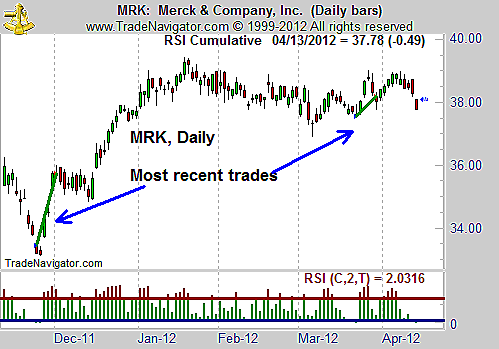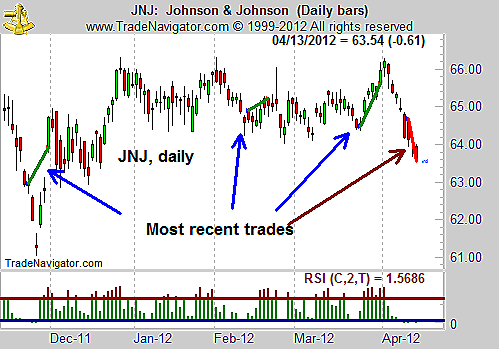
HOT TOPICS LIST
- MACD
- Fibonacci
- RSI
- Gann
- ADXR
- Stochastics
- Volume
- Triangles
- Futures
- Cycles
- Volatility
- ZIGZAG
- MESA
- Retracement
- Aroon
INDICATORS LIST
LIST OF TOPICS
PRINT THIS ARTICLE
by Mike Carr, CMT
Volatile tech stocks are usually considered as favorites among short-term traders. Large caps could also be considered as trading candidates.
Position: Buy
Mike Carr, CMT
Mike Carr, CMT, is a member of the Market Technicians Association, and editor of the MTA's newsletter, Technically Speaking. He is also the author of "Smarter Investing in Any Economy: The Definitive Guide to Relative Strength Investing," and "Conquering the Divide: How to Use Economic Indicators to Catch Stock Market Trends."
PRINT THIS ARTICLE
RSI
Large Caps For Short-Term Trading
04/18/12 08:38:52 AMby Mike Carr, CMT
Volatile tech stocks are usually considered as favorites among short-term traders. Large caps could also be considered as trading candidates.
Position: Buy
| Daytraders generally use index futures or volatile tech stocks in order to maximize gains in minimum time. These trading choices seem logical since the goal is a quick and sharp move. But large-cap, dividend-paying stocks could also deliver for traders if given the chance. Before testing this idea, daytrading needs to be defined. This idea seemed to become popular in the early 1990s when individuals gained access to detailed bid/ask data. At the time, odd lots (trades under 100 shares) got preferential treatment and were executed first. If an odd lot could be executed between the bid and ask, then a trader had a very quick and very small profit. Doing this hundreds of times a day could be enough to trade for a living. Markets change, and odd lots lost that preferential treatment. Daytrading evolved to hyperactive trading during the Internet bubble and eventually to high-frequency trading, which is dominated by firms dedicated to that pursuit. Individuals can still make money from short-term trades, but many have moved to longer holding periods, since they cannot compete with firms dedicated to keeping them from profiting from the very short-term trades. |
| For those willing to hold positions for a day to a week, the two-period relative strength index (RSI) is a useful indicator. Analyst Larry Connors developed this trading strategy and has written extensively on it. While there are specific refinements possible, in general the buy signal comes when a stock or index becomes deeply oversold, according to the indicator. Using a two-day RSI, oversold could be readings of less than 10 or 5. The strategy can also be used to identify short trades. A simple time stop can be used to exit by selling after a day or any other time. That simple and complete strategy -- buy when the two-day RSI is below 5 and sell after holding for several days -- is profitable on almost any security tested and usually over all time frames up to a week. Screening for trading candidates with the two-day RSI can give traders a number of opportunities on most days. |
| Recently, the list of trading candidates included Johnson & Johnson (JNJ) and Merck (MRK). This screen was run after the market close on April 13, and 98 stocks closed with the RSI below 5. One advantage to trading the largest stocks on the list is that trading costs will be lower. Commissions are the same on any stock, but spreads on the most liquid stocks are usually very small, and that allows the trader to get in and out quickly and at low cost. There are also very deep options markets in these large-cap stocks and traders can benefit from the strategy with low costs and relatively small spreads on options. MRK has been profitable over holding periods of one to five days. For a five-day holding period, the strategy delivered a win 52% of the time and the profit factor is 1.52. The most recent trades are highlighted in Figure 1. |

|
| FIGURE 1: MRK, DAILY. Traders can expect for the two-day RSI to fall below 5 about nine times a year, on average. |
| Graphic provided by: Trade Navigator. |
| |
| JNJ has been profitable 57% of the time, with a one-week holding period and the profit factor at that time frame is 1.83. Recent trades are shown in Figure 2. Any exit from one to five days is profitable in testing. |

|
| FIGURE 2: JNJ, DAILY. JNJ offers eight trade setups a year, on average, with this strategy. |
| Graphic provided by: Trade Navigator. |
| |
| There are many ways to refine this strategy and create a personalized exit strategy. The two-day RSI is a system that most traders looking for short-term strategies should consider. |
Mike Carr, CMT, is a member of the Market Technicians Association, and editor of the MTA's newsletter, Technically Speaking. He is also the author of "Smarter Investing in Any Economy: The Definitive Guide to Relative Strength Investing," and "Conquering the Divide: How to Use Economic Indicators to Catch Stock Market Trends."
| Website: | www.moneynews.com/blogs/MichaelCarr/id-73 |
| E-mail address: | marketstrategist@gmail.com |
Click here for more information about our publications!
Comments

|

Request Information From Our Sponsors
- StockCharts.com, Inc.
- Candle Patterns
- Candlestick Charting Explained
- Intermarket Technical Analysis
- John Murphy on Chart Analysis
- John Murphy's Chart Pattern Recognition
- John Murphy's Market Message
- MurphyExplainsMarketAnalysis-Intermarket Analysis
- MurphyExplainsMarketAnalysis-Visual Analysis
- StockCharts.com
- Technical Analysis of the Financial Markets
- The Visual Investor
- VectorVest, Inc.
- Executive Premier Workshop
- One-Day Options Course
- OptionsPro
- Retirement Income Workshop
- Sure-Fire Trading Systems (VectorVest, Inc.)
- Trading as a Business Workshop
- VectorVest 7 EOD
- VectorVest 7 RealTime/IntraDay
- VectorVest AutoTester
- VectorVest Educational Services
- VectorVest OnLine
- VectorVest Options Analyzer
- VectorVest ProGraphics v6.0
- VectorVest ProTrader 7
- VectorVest RealTime Derby Tool
- VectorVest Simulator
- VectorVest Variator
- VectorVest Watchdog
